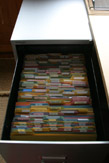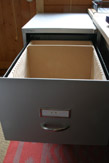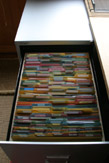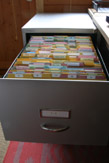Getting Things Done in the UK
 I listened to the abridged version of
Getting
Things Done by David Allen in Spring 2004. Whilst listening to
it the first time, I started installing the system and learning the
techniques. Over the course of several months, I listened to the
book again a few times and continued to refine my understanding and
practice. In late November, I attended David Allen's two day seminar
entitled "Getting Things Done: Mastering Workflow, Projects,
and Priorities". During the seminar, I really got this
methodology at a whole new level. At some point, I may write an
article covering this in more detail. For now, I'll just say that if
your life is very complicated and you want to learn to be effective
and calm, the practice of this simple methodology can produce
amazing results.
I listened to the abridged version of
Getting
Things Done by David Allen in Spring 2004. Whilst listening to
it the first time, I started installing the system and learning the
techniques. Over the course of several months, I listened to the
book again a few times and continued to refine my understanding and
practice. In late November, I attended David Allen's two day seminar
entitled "Getting Things Done: Mastering Workflow, Projects,
and Priorities". During the seminar, I really got this
methodology at a whole new level. At some point, I may write an
article covering this in more detail. For now, I'll just say that if
your life is very complicated and you want to learn to be effective
and calm, the practice of this simple methodology can produce
amazing results.
From here on, I'm assuming that you have read the book. I'm going to explain a solution for implementing the paper filing guidelines in the UK.
I've lived in both the USA and the UK while using this methodology and due to this, have developed some interesting insights. In the book, David explains why he prefers using simple file folders, rather than hanging files. He also explains that the compression plate, present in a lot of US filing cabinets, can be used to hold the files up. Before continuing, let me explain that I have a lot of material on different paper sizes, mainly A4 and letter.
Having used the file folders and filing cabinets to which he's referring, I know that this works really well. The setup I used in the USA consisted of Smead high quality, letter sized, two-pli tabbed file folders (in assorted colors), and a Hon filing cabinet. The folders and cabinets are available from OfficeMax. The file folders sat in the drawer with little space to the sides and with the tabs high up and visible in the drawer. Additionally, the compression plate slid back and forth behind the files, by pulling up on a lever. The compression plate could move in increments of about half an inch. Again, this solution worked really well. The only potential problem I encountered with letter sized file folders was that A4 sheets would poke out of the ends slightly. However, the width of the drawer was just enough for this not to be an issue.
When I set up a system in the UK, I chose a Bisley foolscap 2 drawer filing cabinet. I've recently bought another one of these, as I needed more space. The reason for choosing foolscap was that letter size is slightly wider than A4 and it would have obscured the tabs. Foolscap is wider and longer than both A4 and letter (though not as long as US legal). I was able to buy these cabinets from my local Staples store, though the "Classic" model (which I have) is not featured on the Bisley website.
The first real problem I encountered was finding tabbed file folders. They just don't seem to be popular in the UK. I imagine that most people use square cut file folders in hanging files, as there seems to be a large selection of these products available. Eventually, I found ones that were approximately what I was looking for at stationarystore.co.uk. The ones I recommend are Avery 290 gsm Tabbed Folders, which are the heaviest weight available. I have them in a selection of yellow, pink, green and blue, just because I like to see a lot of color when I open my filing cabinet.
The second problem was related to compression plates. There are slots at the bottom of the Bisley filing cabinet drawers, which accept compression plates. Eventually, I found these compression plates for sale at euroffice.co.uk, and purchased some. Unfortunately, I found them to be inappropriate for my needs, because they are hard to move and cannot be placed with enough precision.
The first picture shows what the filing cabinet drawer looked like with this setup. This may look reasonable to you, but it was very dissatisfying to me after having used the setup in the US. The first problem is that the folders are really loose horizontally in the drawer resulting in them either looking messy or me having to keep "aligning" them. The second problem is that the folders are really sunken down in the draw, making them hard to see.
A friend of mine made a pair of wooden inserts for the file drawers (see the second picture). The insert fits the draw and raises the file folders up, while holding them snugly horizontally. It also has slots in the sides, spaced at 20 mm and a compression plate that fits into them. Moving the compression plate is very easy and can be done from in front of the filing cabinet, unlike the Bisley compression plate.
This is a great solution and is show being used in the third picture. I think that this is even better than the US setup. The tabs on the file folders sit up as high as possible and because the file folders fit into the liner with only a small amount of play, just inserting them is enough to keep them tidy.
The fourth picture shows another view of the result, from a seated position in front of the cabinet.
These liners retail at £200 (+ shipping) for a pair. For further information, or to order, please email me at duncan@riach.org.



